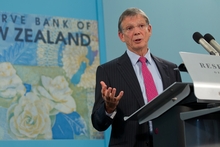Oct 24, 2014
Low CPI tipped to hold rate rise

Economists now expect the Reserve Bank to keep interest rates on hold until September next year after inflation in the September quarter proved even more benign than it had forecast.
The consumers price index rose 0.3 per cent in the quarter, when the median market forecast had been 0.5 per cent and the Reserve Bank’s 0.7 per cent.
Westpac and ASB have pushed back their forecasts of when the Reserve Bank will next raise the official cash rate to September 2015.
The recent plunge in global commodity prices raised the possibility of lower food and petrol prices in the months ahead and NZIER’s quarterly survey of business opinion showed little evidence that businesses are experiencing undue cost increases, said Westpac chief economist Dominick Stephens.
“Our latest forecasts have inflation remaining at 1 per cent in December 2014, and 1.3 per cent in March 2015.” Bank of New Zealand and Deutsche Bank also expect no OCR increase until next September.
ANZ economist Mark Smith said: “We now expect the resumption of rate hikes at the end of 2015, with low CPI out-turns until then tying the Reserve Bank’s hands.”
The annual inflation rate dropped to 1 per cent, the bottom of the Reserve Bank’s 1 to 3 per cent target band. It is the third quarter in a row that the rate has undershot its expectations.
The bank announced last month it would keep rates on hold while it undertook a period of “monitoring and assessment”, acknowledging in effect that strong net immigration and a construction boom were proving less inflationary than past experience would have indicated.
In addition, nearly half the CPI is made up of tradables, that is, items whose prices are driven by world prices and the exchange rate. Tradables inflation was just 0.1 per cent in the latest quarter and over the year tradables prices fell 1 per cent.
There is little global inflation to import.
The decline in export dairy prices is part of a broad decline in commodity prices, said AMP Capital’s head of investment strategy Keith Poore.
In the United States inflation is still running below the Federal Reserve’s target of 2 per cent despite six years of a zero policy rate and US$3.5 trillion of quantitative easing, Poore said. In Europe inflation is consistently below 1 per cent and in China it is only 2 per cent.
In New Zealand nearly three-quarters of what inflation there was in the September quarter came from the housing and utilities sub-group, which makes up nearly a quarter of the CPI.
Prices for newly built houses (excluding land) rose 1.1 per cent in the quarter, making 4.8 per cent for the year. That is nationwide. In Auckland the annual rise in construction costs was 5.7 per cent and the trend is rising, while in Canterbury it was 5.9 per cent but the trend is falling.
Local body rates rose 3.8 per cent; the annual rise in rates largely comes through in the September quarter.
Rents rose 0.6 per cent in the quarter including 0.7 per cent in Auckland, making 2.2 per cent for the year both in the city and nationwide.
Electricity recorded a drop of 0.2 per cent in the September quarter but is still up 3.7 per cent over the year.
